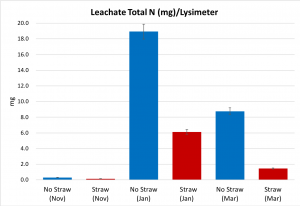For many livestock producers, manure storage capacity is limited. Severe weather events can intensify the manure storage capacity limitations. One option available to producers is to haul manure to the field and place it in manure staging areas. This can reduce the manure storage capacity needed at the livestock facility, and reduce manure hauling time in the spring. Hauling of manure to manure staging areas is typically done when convenient, with little thought about the effect of timing and nutrient loss. This study examined nutrient loss from manure staging piles placed in November, January, and March over a course of five years.
What Did We Do?
This study compared manure staging areas with manure placed at three different times (November, January, and March) and two different bedding materials (straw, no straw).
For each placement event (November, January, March) manure from the tie stall barn (straw bedding) and the butterfly sheds (sand bedding) at the Utah State University Caine Dairy was hauled to Cache Junction, UT and placed in manure staging piles. Composite manure samples were collected from each pile (manure type) at the time of placement, and at removal each year (in the fall after crop harvest) for five years. Manure samples were analyzed for ammonium-nitrogen using Method 12-107-04-1-F on a Lachat Flow Injection Analysis (FIA) analyzer and total N using an Elementar combustion analyzer. Leachate was collected biweekly by means of zero-tension lysimeters installed under the manure staging areas and analyzed for ammonium-nitrogen using Method 10-107-06-2-O and nitrate-nitrogen using Method 10-107-04-1-R on a Lachat FIA analyzer. Soil samples were taken to a depth of 90 cm and analyzed for nitrate-nitrogen using Method 12-107-04-1-F on a Lachat FIA analyzer.
What Have We Learned?

Significant leachate was produced under the manure staging piles placed during the winter months, with the manure with no straw (sand bedding) producing more leachate than the manure with straw (straw bedding). Manure piles placed in November produced less leachate and lost less total N than those placed in January and March (Figure 1). Due to Utah’s dry climate, this is most likely due to drying of the manure in the late fall months, which enabled the manure to absorb more moisture during the winter months. Manure piles placed in January produced the most leachate and exhibited more total N loss (Figure 2).

The snow and snow melt most likely contributed to the large amount of leachate and nitrogen loss observed under the January piles.
Future Plans
The results of this study indicate that straw bedding helps retain the nitrogen in the manure and reduce nitrogen loss from manure placed in manure staging piles. In addition, in Utah’s dry climate, the timing of manure staging pile placement does affect nutrient loss with placement in late November minimizing nutrient leaching. This information will be presented to producers, NRCS, DWQ, and other ag professionals.
Authors
Rhonda Miller, Ph.D.; Agricultural Systems Technology and Education Dept.; Utah State University, rhonda.miller@usu.edu
Jennifer Long; Agricultural Systems Technology and Education Dept.; Utah State University
Additional Information
Website: http://agwastemanagement.usu.edu
Acknowledgements
The authors gratefully acknowledge support from Utah State University Experiment Station.
The authors are solely responsible for the content of these proceedings. The technical information does not necessarily reflect the official position of the sponsoring agencies or institutions represented by planning committee members, and inclusion and distribution herein does not constitute an endorsement of views expressed by the same. Printed materials included herein are not refereed publications. Citations should appear as follows. EXAMPLE: Authors. 2019. Title of presentation. Waste to Worth. Minneapolis, MN. April 22-26, 2019. URL of this page. Accessed on: today’s date.

